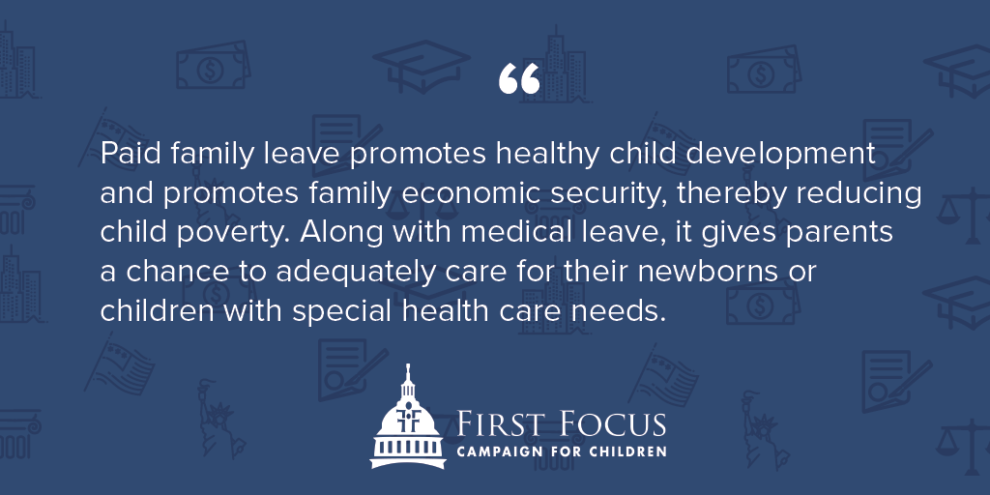
The United States lags behind the rest of the developed world when it comes to paid family leave.
We are the only OECD (Organization for Economic Co-Operation and Development) country that does not provide paid maternity leave nationwide. More than half of the nations in the OECD provide paternity leave to fathers, and paid leave is given to both parents in 23 OECD countries.
Paid family leave promotes healthy child development and promotes family economic security, thereby reducing child poverty. Along with medical leave, it gives parents a chance to adequately care for their newborns or children with special health care needs. This care entails everything from flexibility with breastfeeding to the ability to take time off to bring children to medical appointments without increasing financial strain.
There has been growing momentum towards addressing the lack of paid family leave in the U.S., but a recent hearing by a subcommittee of the Senate Finance Committee showed there is not compromise on the approach.
There are two competing plans to resolve this issue in Congress. Both of these bills seek to create a federal 12-week paid family leave requirement, but they pull funding from different places and define leave differently.
Sen. Joni Ernst (R-IA) testified that she and Sens. Marco Rubio (R-FL) and Mike Lee (R-UT) have been working on a bill to fund paid family leave by allowing new parents to use Social Security benefits to cover that time. In the long-term, this would hurt low-income families, creating financial stress as they age into retirement.
Sen. Kirsten Gillibrand (D-NY) testified about her bill in the hearing, the Family and Medical Insurance Leave Act (FAMILY Act), legislation she first introduced with Rep. Rosa DeLauro (D-CT) in 2013, which proposes creating access to paid family leave through an earned benefit that workers buy into with every paycheck.
First Focus Campaign for Children supports the FAMILY Act because it is more inclusive of various types of family dynamics and financial situations. Here are 4 reasons why:
-
- Overall, children’s health outcomes improve when a parent is directly involved in their treatment and development. Studies show that children heal faster when parents are involved in treatment, preventative childcare levels increase with parents availability, and the ability to provide support for children coping with chronic mental or physical health problems increases. Paid parental leave also largely increases flexibility for a mother to breastfeed her newborn child. Research shows that breastfeeding is associated with a wealth of health benefits among newborns, such as lower risk for infection and sudden infant death syndrome, and reduced risk of premenopausal breast and ovarian cancer for women. One study concluded that, in examining a large U.S company, parents who had trouble taking time off were far less likely to have their children immunized. Much like maternal leave, paternity leave is proven to create greater gender equality in households and is associated with positive cognitive and social development in young children. Returning to work prior to six weeks after giving birth puts mothers at a greater risk for postpartum depression, but as recently as 2015, 1 in 4 women returned to work just two weeks after giving birth.
- Based on what we know about the proposal from Sens. Ernst, Rubio and Lee, individuals would lose retirement funds each time they take paid family leave. Funding paid family leave with Social Security benefits disproportionately harms women, who work only about 75% of the years men work, typically due to taking on caregiving roles. This discourages family growth, as new parents — especially women, who on average get only $1,154 a month in retirement funds from Social Security — will not have the flexibility to take leave multiple times. Paid family leave is about ensuring financial stability when time off is needed, which shouldn’t come at the expense of financial stability in the future, and this is of particular concern for women and new mothers.
- Sen. Rubio announced on Twitter that his plan for paid family leave makes it “optional” for workers to cash in on the benefit, emphasizing that nobody is “taking” Social Security benefits away, but people can choose to use them to pay for family leave. This is worrisome because people who need leave may not do so in an attempt to preserve their retirement funds, and a lack of new-parental leave specifically is harmful to children and families. According to a study from Public Health Report, an increase of 10 weeks paid maternity leave predicted a 10% decrease in neonatal and infant mortality rates.
- The proposal from Sens. Ernst, Rubio and Lee in its current form only focuses on the importance of paid family leave for infant care, which excludes people who may need paid family leave in order to financially support themselves and their families in the wake of other issues. Without access to paid medical leave, workers may be forced to take sick and vacation days or even lose their job in order to care for their parents, older children, spouses or other family members in a time of medical need.According to a 2014 report from the U.S. Census Bureau, the population aged over 65 will be double what is was in 2012 by 2050. With a growing aging population, our nation must be ready to support the increasing amount of unpaid caregivers who will have to take time off work to care for a spouse, parent, or other loved ones.
About 80 percent of care at home is provided by unpaid caregivers, more frequently women, and the FAMILY Act would equip families with the economic security they may need in such a position. Sen. Gillibrand said it best in her testimony at the hearing: “Whatever the case, no working American should ever have to choose between their family and their paycheck.”